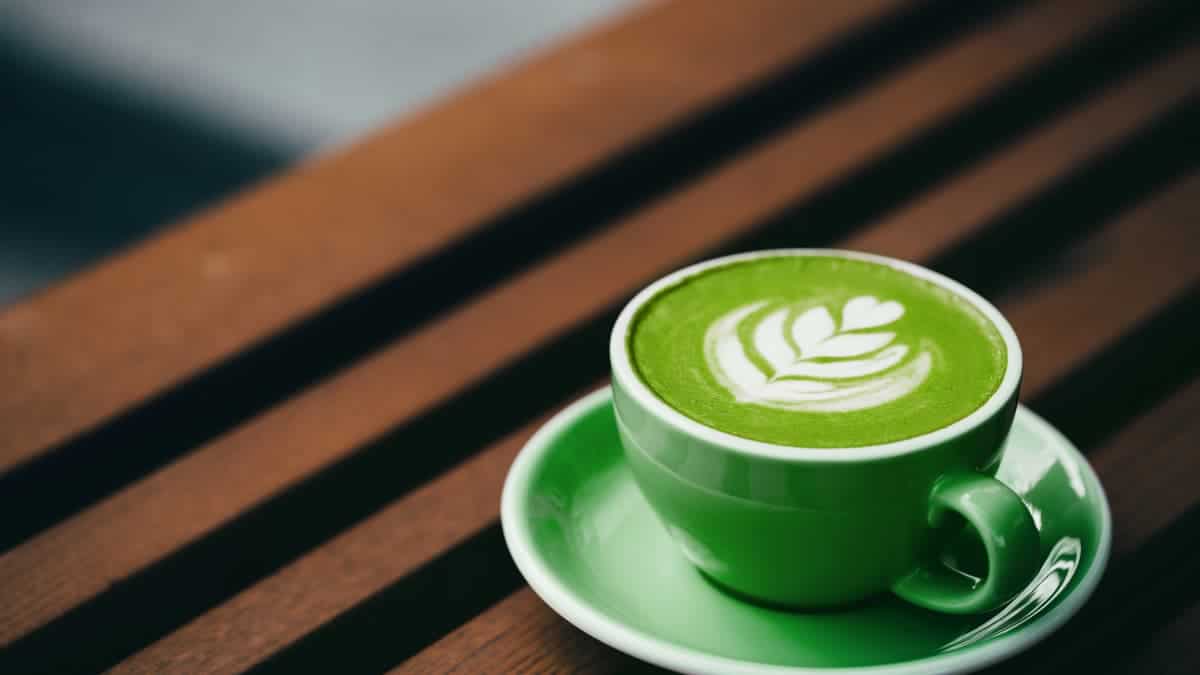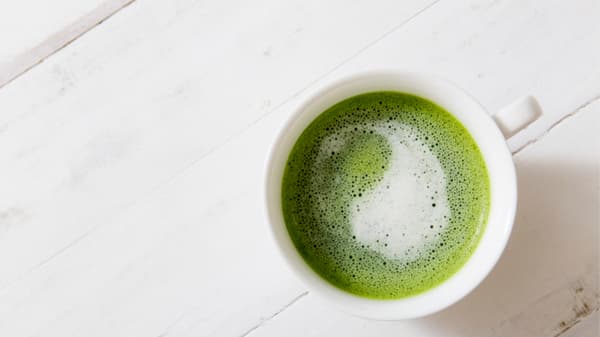What Is A Matcha Latte & How Do You Make One?
You’ve seen those gorgeous green milky drinks on Instagram. Maybe you’ve asked yourself how they paint coffee such a vivid green.
Actually, those green coffee-looking drinks aren’t coffee at all. They’re matcha lattes.
Now your mind might be filled with even more questions. What is a matcha latte, and how does matcha become a latte? What does it taste like, and what does all this have to do with coffee?
And most important of all, should you be drinking them?

What Is A Matcha Latte?
What is a matcha latte? Matcha lattes are a drink made of matcha green tea powder and milk. The combination creates a creamy beverage that can be served hot or over ice.
The ground green tea powder that’s used to make matcha is green tea leaves from the Camellia sinensis plant. Matcha leaves are grown in the shade, which you can see when you look at the drink.
That deep green color you see is from an abundance of chlorophyll in the leaves, which develops in shady conditions. The leaves are ground into a powder and then used to make matcha tea.
To make that powder into a matcha latte, it’s mixed with water until it’s well incorporated, and then milk or cream is added. That makes for a hot creamy beverage that can be as comforting as it is irresistibly smooth.
If you don’t want to consume dairy, you can use a dairy substitute. Milk substitutes for a vegan version of matcha lattes can include coconut milk, almond milk, oat milk or cashew milk.

What Is In A Matcha Latte?
The ingredients for a matcha latte are simple. Most recipes start with matcha powder and hot water. Coffee shops then pour in steamed milk froth or a substitute.
At home, you can prevent lumping by using a whisk to incorporate the powder into warm water. Using a whisk also makes the tea frothy. Then add milk or cream.
You can sweeten your matcha lattes with any sweetener you would like, but you more often see them sweetened with honey or another non-sugar sweetener.
Some people like their beverage with a splash of vanilla syrup or maple syrup, or they top it with whipped cream. Serve it in a mug like an espresso-based drink, but without the coffee.
Don’t limit yourself to the hot version of matcha. You can also enjoy an iced matcha latte. Once you have dissolved the matcha powder, add your cold milk product of choice and plenty of ice. The ice makes matcha lattes refreshing on summer days.
So although it’s called a latte, what you’re consuming is a tea-based drink instead of coffee. That doesn’t mean it won’t give you an energy boost, though. Let’s tackle the subject of caffeine content in a matcha tea latte.
Does Matcha Latte Have Caffeine?
Since a matcha latte is made with green tea, it certainly does have caffeine. How much it will have depends on how it’s prepared.
You may want to compare it to an average green tea, which has about 28 mg in an 8-ounce serving. Matcha, though, is different from a normal cup of green tea.
Matcha tea powder is tea leaves that have been ground up. When you drink a matcha latte, you’re not just consuming an infusion made from green tea leaves. You’re actually drinking every bit of the tea leaves.
Since you’re consuming the whole leaf, you can count on getting more caffeine in a matcha latte. Most recipes recommend using 1 teaspoon of tea powder for each 8-ounce serving.
To calculate how much of an energy boost that will give you, keep in mind that 1 teaspoon has about 65 mg.
But the content in a matcha latte can vary from 25 to 130 mg depending on how much powder the coffee shop uses. For instance, a Starbucks matcha latte has 80 mg of caffeine for a 16-ounce serving.
That amount in 1 teaspoon of matcha – 65 mg – is also what you’ll get from a shot of espresso coffee. A typical latte made with coffee has the same amount, since lattes and cappuccinos are generally made with one shot of espresso.
That puts all those espresso drinks in head-to-head caffeine competition with matcha lattes. Drip coffee still provides more of a jolt, with as much as 120 mg per serving depending on how it was brewed.

Matcha Latte Taste
Matcha lattes are satisfyingly smooth and creamy, similar to an espresso-based latte. But if you’ve never had a matcha latte, you might be wondering what that vivid green drink tastes like.
The flavor of matcha lattes can vary greatly depending on the quality of the matcha that was used. Ceremonial grade matcha, which is the highest quality, will be smooth, slightly sweet, and not bitter.
Lower grades have a slightly bitter hint. Premium matcha, which is made with younger matcha leaves, tastes fresh and less intense.
Culinary grade matcha can be quite intense and bitter and is best used for cooking. So if you decide to make up a batch of matcha cookies or cupcakes, when the recipe calls for matcha, feel free to use the less expensive culinary grade.
Given the color, it’s not surprising that a matcha green tea latte does have a slightly savory and grassy flavor.
The high chlorophyll and amino acid content gives it a bit of an umami taste. Dairy added to matcha can balance it out and make it sweeter and less intense.
Matcha Powder History
What is matcha?
When you hear the word matcha, you might associate it with Japan, and there’s a good reason for that. Japan has been growing and drinking matcha for over 800 years.
What fewer people know is that matcha originated in China and only arrived in Japan in the 12th century. It has an honored role in the Japanese tea ceremony.
Although matcha has been popular for centuries in Japan, it’s only been in the last few years that it has swept around the globe. It fascinates people with its vivid color, unique flavor, and surprising health benefits.
Since with matcha you consume the whole leaf and not just an infusion made from the leaves, with each cup you ingest all that matcha goodness.
So, does it have any health benefits?
Green tea is high in antioxidants. Sometimes we think of getting our antioxidants from what we eat, but with matcha tea we’re getting it in a drink that tastes good.
And the medical community attributes numerous health benefits to green tea. It can prevent health problems and diseases, including high blood pressure, cancer, and heart disease.
In addition to those health benefits, it might even help regular consumers with weight loss. And it will help keep your energy levels high.
Where did matcha latte become a thing?
Famous actors and social media have propelled the worldwide matcha tea craze. In the United States, you’ll now find it in smoothies and frozen yogurt.
Recipes for cookies and cupcakes include it. And, of course, many coffee shops include it on their menus as a milky drink.
If you’re not the type to jump on the food trend bandwagon, don’t let the matcha latte craze discourage you from enjoying true matcha.
Both in its purest form or in a matcha latte, it’s a delicious drink that may give you a number of health benefits.
Try making matcha lattes at home with the simple matcha latte recipe of adding 1 tsp of matcha to warm water and then whisk. Then simply pour in the dairy product of your choice.
If you like your matcha latte sweetened, add sugar, honey or vanilla. If you prefer drinking your matcha latte cold, try it iced. Enjoy your delicious matcha latte and feel connected to centuries of tea drinking history.

